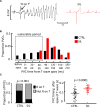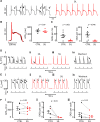PDE5 Inhibition Suppresses Ventricular Arrhythmias by Reducing SR Ca2+ Content
- PMID: 34247494
- PMCID: PMC8409902
- DOI: 10.1161/CIRCRESAHA.121.318473
PDE5 Inhibition Suppresses Ventricular Arrhythmias by Reducing SR Ca2+ Content
Abstract
[Figure: see text].
Keywords: calcium; long QT syndrome; sildenafil citrate.
Figures








Comment in
-
Phosphodiesterase 5: A Novel Therapeutic Target in Long QT Syndrome.Circ Res. 2021 Sep 3;129(6):666-668. doi: 10.1161/CIRCRESAHA.121.319851. Epub 2021 Sep 2. Circ Res. 2021. PMID: 34473532 No abstract available.
References
-
- Jervell A, Lange-nielsen F. Congenital deaf-mutism, functional heart disease with prolongation of the Q-T interval and sudden death. Am Heart J. 1957;54:59–68. doi: 10.1016/0002-8703(57)90079-0 - PubMed
-
- Moss AJ, Schwartz PJ, Crampton RS, Tzivoni D, Locati EH, MacCluer J, Hall WJ, Weitkamp L, Vincent GM, Garson A., Jr.The long QT syndrome. Prospective longitudinal study of 328 families. Circulation. 1991;84:1136–1144. doi: 10.1161/01.cir.84.3.1136 - PubMed
-
- January CT, Riddle JM. Early afterdepolarizations: mechanism of induction and block. A role for L-type Ca2+ current. Circ Res. 1989;64:977–990. doi: 10.1161/01.res.64.5.977 - PubMed
-
- Volders PG, Vos MA, Szabo B, Sipido KR, de Groot SH, Gorgels AP, Wellens HJ, Lazzara R. Progress in the understanding of cardiac early afterdepolarizations and Torsades de Pointes: time to revise current concepts. Cardiovasc Res. 2000;46:376–392. doi: 10.1016/s0008-6363(00)00022-5 - PubMed
Publication types
MeSH terms
Substances
Grants and funding
LinkOut - more resources
Full Text Sources
Research Materials
Miscellaneous

